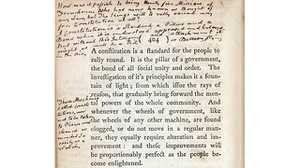A Revolutionary War
While John Adams called for a declaration of independence in the Continental Congress, a down-on-his-luck Englishman named Thomas Paine sounded the clarion call for revolution in January 1776 with his pamphlet Common Sense. So bold was its rhetoric that many delegates thought the anonymously published pamphlet was the work of Adams. Although flattered, Adams was not in total agreement with its sentiments. "Indeed," Adams wrote to Abigail, for whom he had purchased a copy, "this writer has a better hand in pulling down than building up." Adams knew the American Revolution had to build up a new government, not merely destroy the current system.

Uncertain Times
On April 19, 1775, Paul Revere and William Dawes rode from Boston to Lexington to alert the Minute Man — the colonial militia — that the British were on their way to Concord to destroy the colonists' munitions. Fighting first broke out in Lexington (the fabled "shot heard round the world"), then in Concord. The day ended in a British retreat to Boston. But the war would be long — John Adams had predicted it might span 10 years — and the outcome never assured.

Uneasy Defeat
On June 17, the Americans experienced their first major battle (and defeat) at the Battle of Bunker Hill. Victory wasn't easy for the British. Some 40 percent of their troops — 1,000 men — were killed or wounded there. Abigail and seven-year-old John Quincy Adams watched the battle smoke from a hill in Braintree.
The Trend Continues
American defeats were frequent. The army staged an ill-fated attack on Quebec, which provided the British a good base from which to invade New York and New England. As the Second Continental Congress approved the Declaration of Independence in Philadelphia, New York City fell to a British fleet of 30,000 soldiers and Hessian mercenaries, German soldiers-for-hire.
Victory Boosts Morale
On Christmas night, 1776, General George Washington, head of the Continental Army, finally scored his first solid victory. Washington and his troops crossed the icy Delaware River and forced Hessian troops from Trenton, New Jersey. Ultimately Washington could not hold the town, but the victory boosted the morale of the despondent army, for the Americans had killed, wounded, or captured nearly 950 of the enemy.
France Joins the War
A crucial turning point in the war came at the end of 1777, in Saratoga, New York, where 7,000 British troops surrendered to General Horatio Gates. America's victory at Saratoga convinced France to enter the war. Afraid of instigating another English declaration of war, the French had been supporting the American army in secret. After Saratoga, France recognized the United States as an independent nation, signed an alliance, and openly provided naval assistance.

A Population Divided
Even with their powerful new ally, the Americans remained in dire straits. Enlistments were down and conscription, while utilized, was unpopular. In 1779 the American economy collapsed. Furthermore, not all Americans found the cause "glorious." About 20 percent of the active population remained loyal to the crown, many in the South, scene of the Americans' worst defeat, at Charleston, South Carolina, where the Continental Army surrendered 5,500 men.
The Price of Freedom
In 1781, after six years of fighting, the deciding battle of the Revolution was fought at Yorktown, Virginia. Surrounded by American troops and French warships -- Adams had long fought for a strong naval front -- British General Cornwallis surrendered his huge force of 8,000 men. Great Britain was weary of an expensive, seemingly endless war, and agreed to negotiate peace. On September 3, 1783, Great Britain and the United States signed the Treaty of Paris that recognized the independence of the United States. More than 25,000 men -- a quarter of those who served in the Continental army and Continental navy -- had perished in the fight for independence.







